The Low-Carbon Development Strategy of Russia Until 2050 and the Role of Forests in Its Implementation
Abstract
1. Introduction: The Background of the Situation and the Goals and Objectives of the Study
2. Literature Review
3. Materials and Methods
4. Results: Possible Scenarios to Achieve Carbon Neutrality in the Russian Federation in the New LT LEDS
- (1)
- The ambition of LT LEDS 2021 to increase net absorption in LULUCF will remain unchanged (−693.4 Mln t CO2-eq. in 2060 compared to 2023) while technological decarbonization will decrease.
- (2)
- The ambition of LT LEDS 2021 to decrease emissions through technological decarbonization will remain unchanged (−956.6 Mln t CO2-eq. in 2060 compared to 2023), while net absorption in LULUCF will decrease.
4.1. Reaching Carbon Neutrality and Forest Fires Problem
4.2. Estimates of the Carbon Balance in Russian Forests
4.3. Legal Regulation of Climate Projects in the Forest Lands
4.4. Assessment of Measures to Increase Absorption and Stimulate the Implementation of Climate Projects in the LULUCF Sector in the Draft Operational Plan of LT LEDS
- -
- Indicators of increased absorption of LULUCF on forest lands by year up to 2030 (Section 3.1.1).
- -
- Indicators of the total annual area of forest fires on forest fund lands, which are expected to be reduced by 2030 to 4.2 million hectares by 2030, compared to 10 million hectares in 2019 (Section 3.1.1).
- -
- The stepwise quantitative result of the implementation of climate projects by 2030 in the amount of 20 million tons of CO2-eq., compared with 1 million tons in 2024 (Section 3.1.2).
- -
- Focus on exploring the potential of agroforestry and regenerative agriculture for carbon storage and the implementation of measures and climate projects in this field (Sections 3.2.1.1 and 3.2.1.2).
- -
- Stimulating the implementation of climate projects (Section 3.2.2), which is caused by low current business interest in the implementation of climate projects.
4.5. The Lack of Climate Indicators for the Implementation of Measures in the Draft LT LEDS Operational Plan
5. Discussion: How to Increase Carbon Sequestration by Russian Forests
- -
- Complementing the federal project “Forest Preservation” of the national project “Environmental Well-Being” and the state program “Forestry Development” as the main instruments for financing forestry by the Russian Federation, with quantitative estimates of GHG absorption within the framework of ongoing measures in the field of forestry funded by the federal budget, as well as limiting the requirements for the use of mainly coniferous seedlings in reforestation with a closed root system.
- -
- In accordance with the Decree of the President of the Russian Federation No. 382 of 15 June 2022, setting targets for the federal subjects of the Russian Federation to ensure a reduction in the area of forest fires by at least 50% from the level of 2021 and, accordingly, a reduction in emissions and an increase in forest absorption, within the framework of the prepared LT LEDS Operational plan. This will allow forestry to make a quantitative contribution to achieving carbon neutrality in Russia.
- -
- Implementing regional carbon targets in the forest plans of the subjects of the Russian Federation, the forest management regulations of forest districts and forest development plans.
- -
- Providing for the achievement of these targets both through departmental measures for the mitigation and adaptation of forests, and through the implementation of forest climate projects by private investors.
- -
- Implementing measures to stimulate adaptation measures and climate projects through financial incentives and green financing for private investors. Minimizing administrative and departmental barriers in the implementation of climate projects in forests.
- -
- Removing restrictions on agroforestry for unused agricultural lands if this does not threaten “food security”, which will strengthen measures to protect forests from fires and pests. Approximately 70% of such forests are not planned to be returned to agricultural turnover. In many regions (Vologda region, Kostroma region, Nizhny Novgorod region), agriculture turns out to be economically more sustainable, precisely in cooperation with forest management.
- -
- Defining, at the level of the carbon unit registry, the best practices for the implementation of climate projects in the forest, including issues related to determining the baseline, project scenario and additionality.
- -
- Taking measures to harmonize Russian methodologies and the work of validation and verification authorities with international requirements in this area. This will be in demand, including within the framework of the upcoming processes of cross-border carbon regulation.
6. Conclusions: The Role of Forests in the Implementation of the Target Scenario of Low-Carbon Development in Russia
Author Contributions
Funding
Institutional Review Board Statement
Informed Consent Statement
Data Availability Statement
Acknowledgments
Conflicts of Interest
Abbreviations
| CCUS | Carbon Capture, Utilization and Storage |
| DACS | Direct Air Capture and Storage |
| EMISS | Unified Interdepartmental Information and Statistical System |
| GDP | Gross domestic product |
| GHG | Greenhouse gases |
| HWP | Harvested wood products |
| IG RAS | Institute of Geography of the Russian Academy of Sciences |
| IGCE | Institute of Global Climate and Ecology named after Academician Yu. A. Israel |
| IPCC | Intergovernmental Panel on Climate Change |
| ISDM-Rosleskhoz | Forest Fires Remote Monitoring Information System of the Federal Forestry Agency |
| LT LEDS | Long term low-emission Development Strategy of Russia |
| LULUCF | Land use, land use change and forestry |
| NDC | Nationally determined contribution |
| NID | National GHG Inventory Document |
| SFI | State Forest Inventory |
| SFR | State Forest Register |
| UNFCCC | United Nations Framework Convention on Climate Change |
| VIP GZ | The significant innovative project of national importance “Unified National Monitoring System of Climatically Active Substances” |
References
- UNFCCC. The Paris Agreement. What Is the Paris Agreement? 2020. Available online: https://unfccc.int/process-and-meetings/the-paris-agreement (accessed on 17 June 2024).
- UNFCCC. Long-Term Strategies Portal. 2024. Available online: https://unfccc.int/process/the-paris-agreement/long-term-strategies (accessed on 24 November 2024).
- Order of the Government of the Russian Federation No. 3052-r Dated 10/29/2021 “On Approval of the Strategy of Socio-Economic Development of the Russian Federation with Low Greenhouse Gas Emissions Until 2050”. Available online: https://www.consultant.ru/document/cons_doc_LAW_399657 (accessed on 16 June 2024). (In Russian).
- UNFCCC. Nationally Determined Contributions Registry. 2024. Available online: https://unfccc.int/NDCREG (accessed on 26 November 2024).
- UNFCCC. Russian Federation. 2024 National Inventory Document (NID). 2024. Available online: https://unfccc.int/documents/642791 (accessed on 26 November 2024).
- Climate Action Tracker. 2022. Available online: https://climateactiontracker.org/countries/russian-federation (accessed on 10 June 2024).
- Long Term Low-Emission Development Strategy of Russia Operational Plan Draft. Available online: https://t.me/greenserpent/19734 (accessed on 24 November 2024).
- The Federal law № 492-by 26.12.2024 “On Amendments to the Forest Code of the Russian Federation (in Order to Create Legal Grounds for the Implementation of Climate Projects in Forests on the Territory of the Russian Federation)”. Available online: http://government.ru/docs/all/157122/ (accessed on 24 November 2024). (In Russian).
- Chen, Q.; Zhang, H.; Lau, Y.-Y.; Wang, T.; Wang, W.; Zhang, G. Climate change, carbon peaks, and carbon neutralization: A bibliometric study from 2006 to 2023. Sustainability 2023, 15, 5723. [Google Scholar] [CrossRef]
- Klimenko, V.V.; Klimenko, A.V.; Tereshin, A.G. Carbon-free Russia: Is there a chance to achieve carbon neutrality by 2060. Dokl. Phys. 2023, 68, 223–232. [Google Scholar] [CrossRef]
- Shao, X.; Zhong, Y.; Li, Y.; Altuntas, M. Does environmental and renewable energy R&D help to achieve carbon neutrality target? A case of the US economy. J. Environ. Manag. 2021, 296, 113229. [Google Scholar] [CrossRef]
- Shirov, A.A.; Kolpakov, A.Y.; Gambhir, A.; Koasidis, K.; Köberle, A.C.; McWilliams, B.; Nikas, A. Stakeholder-driven scenario analysis of ambitious decarbonisation of the Russian economy. Renew. Sustain. Energy Transit. 2023, 4, 100055. [Google Scholar] [CrossRef]
- Zhao, C.; Ju, S.; Xue, Y.; Ren, T.; Ji, Y.; Chen, X. China’s energy transitions for carbon neutrality: Challenges and opportunities. Carbon Neutrality 2022, 1, 7. [Google Scholar] [CrossRef]
- Mo, L.; Zohner, C.M.; Reich, P.B.; Liang, J.; De Miguel, S.; Nabuurs, G.J.; Renner, S.S.; Van Den Hoogen, J.; Araza, A.; Herold, M.; et al. Integrated global assessment of the natural forest carbon potential. Nature 2023, 624, 92–101. [Google Scholar] [CrossRef]
- Sovacool, B.K. Expanding carbon removal to the Global South: Thematic concerns on systems, justice, and climate governance. Energy Clim. Change 2023, 4, 100103. [Google Scholar] [CrossRef]
- Wigneron, J.P.; Ciais, P.; Li, X.; Brandt, M.; Canadell, J.G.; Tian, F.; Wang, H.; Bastos, A.; Fan, L.; Gatica, G.; et al. Global carbon balance of the forest: Satellite-based L-VOD results over the last decade. Front. Remote Sens. 2024, 5, 1338618. [Google Scholar] [CrossRef]
- Zhu, A.L.; Weins, N.; Lu, J.; Harlan, T.; Qian, J.; Seleguim, F.B. China’s nature-based solutions in the Global South: Evidence from Asia, Africa, and Latin America. Glob. Environ. Change 2024, 86, 102842. [Google Scholar] [CrossRef]
- Ptichnikov, A.V.; Shvarts, E.A.; Popova, G.A.; Baibar, A.S. The role of forests in the implementation of Russia’s low-carbon development strategy. Dokl. Earth Sci. 2022, 507, 981–985. [Google Scholar] [CrossRef]
- Ptichnikov, A.V.; Shvarts, E.A.; Popova, G.A.; Baibar, A.S. Low-carbon development strategy of Russia and the role of forests in its implementation. Her. Russ. Acad. Sci. 2023, 93, 36–49. (In Russian) [Google Scholar] [CrossRef]
- Romanovskaya, A.A.; Korotkov, V.N. Balance of anthropogenic and natural greenhouse gas fluxes of all inland ecosystems of the Russian Federation and the contribution of sequestration in forests. Forests 2024, 15, 707. [Google Scholar] [CrossRef]
- Romanovskaya, A.A.; Korotkov, V.N.; Polumieva, P.D.; Trunov, A.A.; Vertyankina, V.Y.; Karaban, R.T. Greenhouse gas fluxes and mitigation potential for managed lands in the Russian Federation. Mitig. Adapt. Strateg. Glob. Change 2020, 25, 661–687. [Google Scholar] [CrossRef]
- Shvarts, E.A.; Ptichnikov, A.V. Low-carbon development strategy of Russia and the role of forests in its implementation. Sci. Work. Free Econ. Soc. Russ. 2022, 236, 399–426. (In Russian) [Google Scholar] [CrossRef]
- Wang, S.; Tan, S.; Xu, J. Evaluation and implication of the policies towards China’s carbon neutrality. Sustainability 2023, 15, 6762. [Google Scholar] [CrossRef]
- Wu, Z.; Huang, X.; Chen, R.; Mao, X.; Qi, X. The United States and China on the paths and policies to carbon neutrality. J. Environ. Manag. 2022, 320, 115785. [Google Scholar] [CrossRef]
- Xu, S. Forestry offsets under China’s certificated emission reduction (CCER) for carbon neutrality: Regulatory gaps and the ways forward. Int. J. Clim. Change Strateg. Manag. 2024, 16, 40–156. [Google Scholar] [CrossRef]
- Yu, Z.; Liu, S.; Li, H.; Liang, J.; Liu, W.; Piao, S.; Tian, H.; Zhou, G.; Lu, C.; You, W.; et al. Maximizing carbon sequestration potential in Chinese forests through optimal management. Nat. Commun. 2024, 15, 3154. [Google Scholar] [CrossRef] [PubMed]
- Korosuo, A.; Pilli, R.; Viñas, R.A.; Blujdea, V.N.B.; Colditz, R.R.; Fiorese, G.; Rossi, S.; Vizzarri, M.; Grassi, G. The role of forests in the EU climate policy: Are we on the right track? Carbon Balance Manag. 2023, 18, 15. [Google Scholar] [CrossRef] [PubMed]
- Lauerwald, R.; Bastos, A.; McGrath, M.J.; Petrescu, A.M.R.; Ritter, F.; Andrew, R.M.; Berchet, A.; Broquet, G.; Brunner, D.; Chevallier, F.; et al. Carbon and greenhouse gas budgets of Europe: Trends, interannual and spatial variability, and their drivers. Glob. Biogeochem. Cycles 2024, 38, e2024GB008141. [Google Scholar] [CrossRef]
- Ogbonna, C.G.; Nwachi, C.C.; Okeoma, I.O.; Fagbami, O.A. Understanding Nigeria’s transition pathway to carbon neutrality using the Multilevel Perspective. Carbon Neutrality 2023, 2, 24. [Google Scholar] [CrossRef]
- Soterroni, A.C.; Império, M.; Scarabello, M.C.; Seddon, N.; Obersteiner, M.; Rochedo, P.R.R.; Schaeffer, R.; Andrade, P.R.; Ramos, F.M.; Azevedo, T.R.; et al. Nature-based solutions are critical for putting Brazil on track towards net-zero emissions by 2050. Glob. Change Biol. 2023, 29, 7085–7101. [Google Scholar] [CrossRef] [PubMed]
- Dai, M.; Sun, M.; Chen, B.; Shi, L.; Jin, M.; Man, Y.; Liang, Z.; Almeida, C.M.V.B.; Li, J.; Zhang, P.; et al. Country-specific net-zero strategies of the pulp and paper industry. Nature 2023, 626, 327–334. [Google Scholar] [CrossRef] [PubMed]
- Bysouth, D.; Boan, J.J.; Malcolm, J.R.; Taylor, A.R. High emissions or carbon neutral? Inclusion of “anthropogenic” forest sinks leads to underreporting of forestry emissions. Front. For. Glob. Change 2024, 6, 1297301. [Google Scholar] [CrossRef]
- Zheng, B.; Ciais, P.; Chevallier, F.; Yang, H.; Canadell, J.G.; Chen, Y.; van der Velde, I.R.; Aben, I.; Chuvieco, E.; Davis, S.J.; et al. Record-high CO2 emissions from boreal fires in 2021. Science 2023, 379, 912–917. [Google Scholar] [CrossRef]
- Zheng, B.; Ciais, P.H.; Chevallier, F.; Chuvieco, E.; Chen, Y.; Yang, H. Increasing forest fire emissions despite the decline in global burned area. Sci. Adv. 2021, 7, eabh2646. [Google Scholar] [CrossRef]
- Loupian, E.A.; Lozin, D.V.; Balashov, I.V.; Bartalev, S.A.; Stytsenko, F.V. A study of the dependence of the degree of forest damage by fires on the intensity of burning according to satellite-monitoring data. Cosm. Res. 2022, 60, S46–S56. [Google Scholar] [CrossRef]
- Lozin, D.V.; Loupian, E.A.; Balashov, I.V.; Bartalev, S.A. Estimation of Northern Burnt Forest Mortality in the 21st Century Based on MODIS Data on Fire Intensity. Cosm. Res. 2023, 61, S118–S124. [Google Scholar] [CrossRef]
- Fan, L.; Wigneron, J.P.; Ciais, P.; Chave, J.; Brandt, M.; Sitch, S.; Yue, C.; Bastos, A.; Li, X.; Qin, Y.; et al. Siberian carbon sink reduced by forest disturbances. Nat. Geosci. 2023, 16, 56–62. [Google Scholar] [CrossRef]
- Kharuk, V.I.; Ponomarev, E.I.; Ivanova, G.A.; Dvinskaya, M.L.; Coogan, S.C.P.; Flannigan, M.D. Wildfires in the Siberian taiga. Ambio 2021, 50, 1953–1974. [Google Scholar] [CrossRef]
- Kukavskaya, E.A.; Shvetsov, E.G.; Buryak, L.V.; Tretyakov, P.D.; Groisman, P.Y. Increasing fuel loads, fire hazard, and carbon emissions from fires in Central Siberia. Fire 2023, 6, 63. [Google Scholar] [CrossRef]
- IPCC. Guidelines for National Greenhouse Gas Inventories; IPCC National Greenhouse Gas Inventories Programme; IPCC: Geneva, Switzerland, 2006. [Google Scholar]
- UNFCCC. Russian Federation. 2023 National Inventory Report (NID). 2023. Available online: https://unfccc.int/documents/631719 (accessed on 20 November 2024).
- Schepaschenko, D.; Moltchanova, E.; Fedorov, S.; Karminov, V.; Ontikov, P.; Santoro, M.; See, L.; Kositsyn, V.; Shvidenko, A.; Romanovskaya, A.; et al. Russian forest sequesters substantially more carbon than previously reported. Sci. Rep. 2021, 11, 12825. [Google Scholar] [CrossRef] [PubMed]
- Bartalev, S.A.; Egorov, V.A.; Zharko, V.O.; Lupyan, E.A.; Plotnikov, D.E.; Khvostikov, S.A.; Shabanov, N.V. Satellite Mapping of Vegetation Cover in Russia; IKI RAS: Moscow, Russia, 2016. (In Russian) [Google Scholar]
- Bartalev, S.A.; Lukina, N.V. New methodology for studying carbon in the forests of Russia from space. Zemlya I Vselennaya 2023, 5, 44–58. (In Russian) [Google Scholar] [CrossRef]
- Shvidenko, A.Z.; Schepaschenko, D.G.; Nilsson, S.; Buluy, Y.I. Tables and Models of Growth and Productivity of Forests of Major Forest Forming Species of Northern Eurasia. In Standard and Reference Materials, 2nd ed.; Federal Agency of Forest Managemen: Moscow, Russia, 2008. [Google Scholar]
- Shvidenko, A.; Mukhortova, L.; Kapitsa, E.; Kiaxner, F.; See, L.; Pyzhev, A.; Gordeev, R.; Fedorov, S.; Korotkov, V.; Bartalev, S.; et al. A Modelling System for Dead Wood Assessment in the Forests of Northern Eurasia. Forests 2023, 14, 45. [Google Scholar] [CrossRef]
- Schepaschenko, D.; Moltchanova, E.; Shvidenko, A.; Blyshchyk, V.; Dmitriev, E.; Martynenko, O.; See, L.; Kraxner, F. Improved Estimates of Biomass Expansion Factors for Russian Forests. Forests 2018, 9, 312. [Google Scholar] [CrossRef]
- IPCC. Refinement to the 2006 IPCC Guidelines for National Greenhouse Gas Inventories; IPCC: Geneva, Switzerland, 2019; Available online: https://www.ipcc-nggip.iges.or.jp/public/2019rf (accessed on 12 February 2025).
- Matveev, A.M.; Bartalev, S.A. A comparative analysis of wildfire carbon emissions estimates in Russia according to global inventories. Sovrem. Probl. Distantsionnogo Zondirovaniya Zemli Iz Kosmosa 2024, 21, 141–161. (In Russian) [Google Scholar] [CrossRef]
- Morkovina, S.S.; Kharchenko, N.N.; Sheshnitsian, S.S.; Panyavina, E.A.; Ivanova, A.V.; Vodolazhskiy, A.I. Ecological and economic assessment of forestry practices efficiency in maintaining carbon balance. Lesn. Vestnik/For. Bull. 2024, 28, 104–117. (In Russian) [Google Scholar] [CrossRef]
- Ministry of Natural Resources and Environment of the Russian Federation Passport of the National Project “Ecology”. 2018. Available online: https://www.mnr.gov.ru/activity/directions/natsionalnyy_proekt_ekologiya/ (accessed on 12 February 2025). (In Russian)
- RIA News. Russia Will Increase Funding for Fighting Forest Fires. 2024. Available online: https://ria.ru/20241008/rossija-1976932385.html (accessed on 12 February 2025). (In Russian).
- Romanovskaya, A.A. Approaches to Implementing Ecosystem Climate Projects in Russia. Reg. Res. Russ. 2023, 13, 609–621. [Google Scholar] [CrossRef]
- Zamolodchikov, D.G.; Grabowsky, V.I.; Shulyak, P.P.; Chestnykh, O.V. Recent decrease in carbon sink to Russian forests. Dokl. Akad. Nauk 2017, 476, 719–721. (In Russian) [Google Scholar] [CrossRef] [PubMed]
- Romanov, A.A.; Tamarovskaya, A.N.; Gloor, E.; Brienen, R.; Gusev, B.A.; Leonenko, E.V.; Vasiliev, A.S.; Krikunov, E.E. Reassessment of carbon emissions from fires and a new estimate of net carbon uptake in Russian forests in 2001–2021. Sci. Total Environ. 2022, 846, 157322. [Google Scholar] [CrossRef] [PubMed]
- Kirillina, K.; Shvetsov, E.G.; Protopopova, V.V.; Thiesmeyer, L.; Yan, W. Consideration of anthropogenic factors in boreal forest fire regime changes during rapid socio-economic development: Case study of forestry districts with increasing burnt area in the Sakha Republic, Russia. Environ. Res. Lett. 2020, 15, 035009. [Google Scholar] [CrossRef]
- Accounts Chamber of the Russian Federation. Bulletin of the Accounts Chamber of the Russian Federation No 4 (305). Forest Protection. 2023. Available online: https://ach.gov.ru/statements/bulletin-sp-4-2023 (accessed on 10 June 2024). (In Russian)
- Accounts Chamber of the Russian Federation. Bulletin of the Accounts Chamber of the Russian Federation No 1 (278). Forest Firefighting Equipment. 2021. Available online: https://ach.gov.ru/statements/byulleten-schetnoy-palaty-1-278-2021-g (accessed on 10 June 2024). (In Russian)
- Filipchuk, A.; Moiseev, B.; Malysheva, N.; Strakhov, V. Russian forests: A new approach to the assessment of carbon stocks and sequestration capacity. Environ. Dev. 2018, 26, 68–75. [Google Scholar] [CrossRef]
- Shvarts, E.A.; Kokorin, A.O.; Ptichnikov, A.V.; Krenke, A.N. Cross-Border Carbon Regulation and Forests in Russia: From Expectations and Myth to Realization of Interests. Econ. Policy 2022, 17, 54–77. [Google Scholar] [CrossRef]
- Filipchuk, A.N.; Moiseev, B.N.; Yugov, A.N. Comparative Assessment of statistics on Growing Stock in Forests of Russian Federation. For. Inf. 2017, 2, 16–25. Available online: https://lhi.vniilm.ru/PDF/2017/2/LHI_2017_02-02-Filipchuk.pdf (accessed on 10 June 2024). (In Russian).
- Ivanov, A.Y.; Durmanov, N.D.; Orlov, M.P.; Piksendeev, K.V.; Rovnov, Y.E.; Luksha, P.O.; Makarov, I.A.; Ptichnikov, A.V.; Stepanov, I.A.; Harchenko, M.M.; et al. Battle for Climate: Carbon Farming as Russia’s Bet: Expert Report; Higher School of Economics Publishing House: Moscow, Russia, 2021. (In Russian) [Google Scholar]
- Filipchuk, A.N.; Malysheva, N.V. The assessment of the feasibility of using the state forest inventory data to implement the national commitments under the Paris Agreement. IOP Conf. Ser. Earth Environ. Sci. 2020, 574, 012026. [Google Scholar] [CrossRef]
- Puzachenko, Y.G.; Kotlov, I.P.; Sandlerskiy, R.B. Analysis of changes of land cover using multispectral remote sensing information in the central forest reserve. Izv. Ross. Akad. Nauk. Seriya Geogr. 2014, 3, 5–18. (In Russian) [Google Scholar] [CrossRef]
- Krenke, A.N.; Ptichnikov, A.V.; Shvarts, E.A.; Petrov, I.K. Assessments of the forest carbon balance in the national climate policies of Russia and Canada. Dokl. Earth Sci. 2021, 501, 1091–1095. [Google Scholar] [CrossRef]
- Harris, N.L.; Gibbs, D.A.; Baccini, A.; Birdsey, R.A.; De Bruin, S.; Farina, M.; Fatoyinbo, L.; Hansen, M.C.; Herold, M.; Houghton, R.A.; et al. Global maps of twenty-first century forest carbon fluxes. Nat. Clim. Change 2021, 11, 234–240. [Google Scholar] [CrossRef]
- Ciais, P.; Canadell, J.; Luyssaert, S.; Chevallier, F.; Shvidenko, A.; Poussi, Z.; Jonas, V.; Peylin, P.; Wayne King, A.; Schulze, E.-D.; et al. Can we reconcile atmospheric estimates of the Northern terrestrial carbon sink with land-based accounting? Curr. Opin. Environ. Sustain. 2010, 2, 225–230. [Google Scholar] [CrossRef]
- Pan, Y.; Birdsey, R.A.; Phillips, O.L.; Houghton, R.A.; Fang, J.; Kauppi, P.E.; Keith, H.; Kurz, W.A.; Ito, A.; Lewis, S.L.; et al. The enduring world forest carbon sink. Nature 2024, 631, 563–569. [Google Scholar] [CrossRef]
- Dolman, A.J.; Shvidenko, A.; Schepaschenko, D.; Ciais, D.; Tchebakova, N.; Chen, T.; Van der Molen, M.K.; Belelli Marchesini, L.; Maximov, T.; Maksyutov, S.; et al. An estimate of the terrestrial carbon budget of Russia using inventory-based, eddy covariance and inversion methods. Biogeosciences 2012, 9, 5323–5340. [Google Scholar] [CrossRef]
- FAO. The Russian Federation Forest Sector: Outlook Study to 2030; FAO: Rome, Italy, 2012. (In Russian) [Google Scholar]
- Filipchuk, A.N.; Malysheva, N.V.; Moiseev, B.N.; Strakhov, V.V. Analytical overview of methodologies calculating missions and absorptions of greenhouse gases by forests from the atmosphere. For. Inf. 2016, 3, 36–85. (In Russian) [Google Scholar]
- Zamolodchikov, D.G.; Grabowsky, V.I.; Shulyak, P.P. Inventory of carbon budget of forestry sector of Russia. Proc. St. Petersburg For. Res. Inst. 2013, 3, 22–32. (In Russian) [Google Scholar]
- Zamolodchikov, D.G.; Grabowsky, V.I.; Kurz, W.A. Influence of forest harvest rates on the carbon balance of Russian forests: Projective analysis using the CBM-CFS3 model. Proc. St. Petersburg For. Res. Inst. 2014, 1, 5–18. (In Russian) [Google Scholar]
- Shvidenko, A.Z.; Schepaschenko, D.G. Carbon budget of Russian forests. Sib. J. For. Sci. 2014, 1, 69–92. (In Russian) [Google Scholar]
- State Report “On the State and Environmental Protection of the Russian Federation in 2015”. Available online: http://www.priroda.ru/lib/detail.php?ID=11585 (accessed on 5 June 2024). (In Russian).
- Girardin, C.A.J.; Jenkins, S.; Seddon, N.; Allen, M.; Lewis, S.L.; Wheeler, C.E.; Griscom, B.W.; Malhi, Y. Nature-based solutions can help cool the planet—If we act now. Nature 2021, 593, 191–194. [Google Scholar] [CrossRef]
- Korotkov, V.N.; Shanin, V.N.; Frolov, P.V. Can artificial reforestation always be a forest climatic project? In Proceedings of the Seventh Conference Mathematical Modeling in Ecology, Vienna, Austria, 9–12 November 2021; Grabarnik, P.Y., Logofet, D.O., Eds.; FRC PNTSBI RAS: Pushchino, Russian, 2021; pp. 57–58. (In Russian). [Google Scholar]
- Shanin, V.N.; Frolov, P.V.; Korotkov, V.N. Can artificial reforestation always be a forest climatic project? For. Sci. Issues 2022, 5, 57. (In Russian) [Google Scholar] [CrossRef]
- Thibault, M.; Bergeron, E.T.Y.; Ouimet, R.; Tremblay, S. Afforestation of abandoned agricultural lands for carbon sequestration: How does it compare with natural succession? Plant Soil 2022, 475, 605–621. [Google Scholar] [CrossRef]
- Jones, J.P.G.; Lewis, S.L. Forest carbon offsets are failing: Analysis reveals emission reductions from forest conservation have been overestimated. Science 2023, 381, 830–831. [Google Scholar] [CrossRef]
- West, T.A.; Wunder, P.S.; Sills, E.O.; Börner, J.; Rifai, S.W.; Neidermeier, A.N.; Frey, G.P.; Kontoleon, A. Action needed to make carbon offsets from forest conservation work for climate change mitigation. Science 2023, 381, 873–877. [Google Scholar] [CrossRef]
- Ptichnikov, A.V.; Shvarts, E.A.; Kuznetsova, D.A. The greenhouse gas absorption potential of Russian forests and possibilities for carbon footprint reduction for exported domestic products. Dokl. Earth Sci. 2021, 449, 683–685. [Google Scholar] [CrossRef]
- Griscom, B.W.; Adams, J.; Ellis, P.W.; Houghton, R.A.; Lomax, G.; Miteva, D.A.; Schlesinger, W.H.; Shoch, D.; Siikamäki, J.V.; Smith, P.; et al. Natural Climate Solutions. Proc. Natl. Acad. Sci. USA 2017, 114, 11645–11650. [Google Scholar] [CrossRef] [PubMed]
- Roe, S.; Streck, C.; Obersteiner, M.; Frank, S.; Griscom, B.; Drouet, L.; Fricko, O.; Gusti, M.; Harris, N.; Hasegawa, T.; et al. Contribution of the land sector to a 1.5 °C world. Nat. Clim. Change 2019, 9, 817–828. [Google Scholar] [CrossRef]
- WEF. Consultation: Nature and Net Zero. 2021. Available online: https://www3.weforum.org/docs/WEF_Consultation_Nature_and_Net_Zero_2021.pdf (accessed on 10 June 2024).
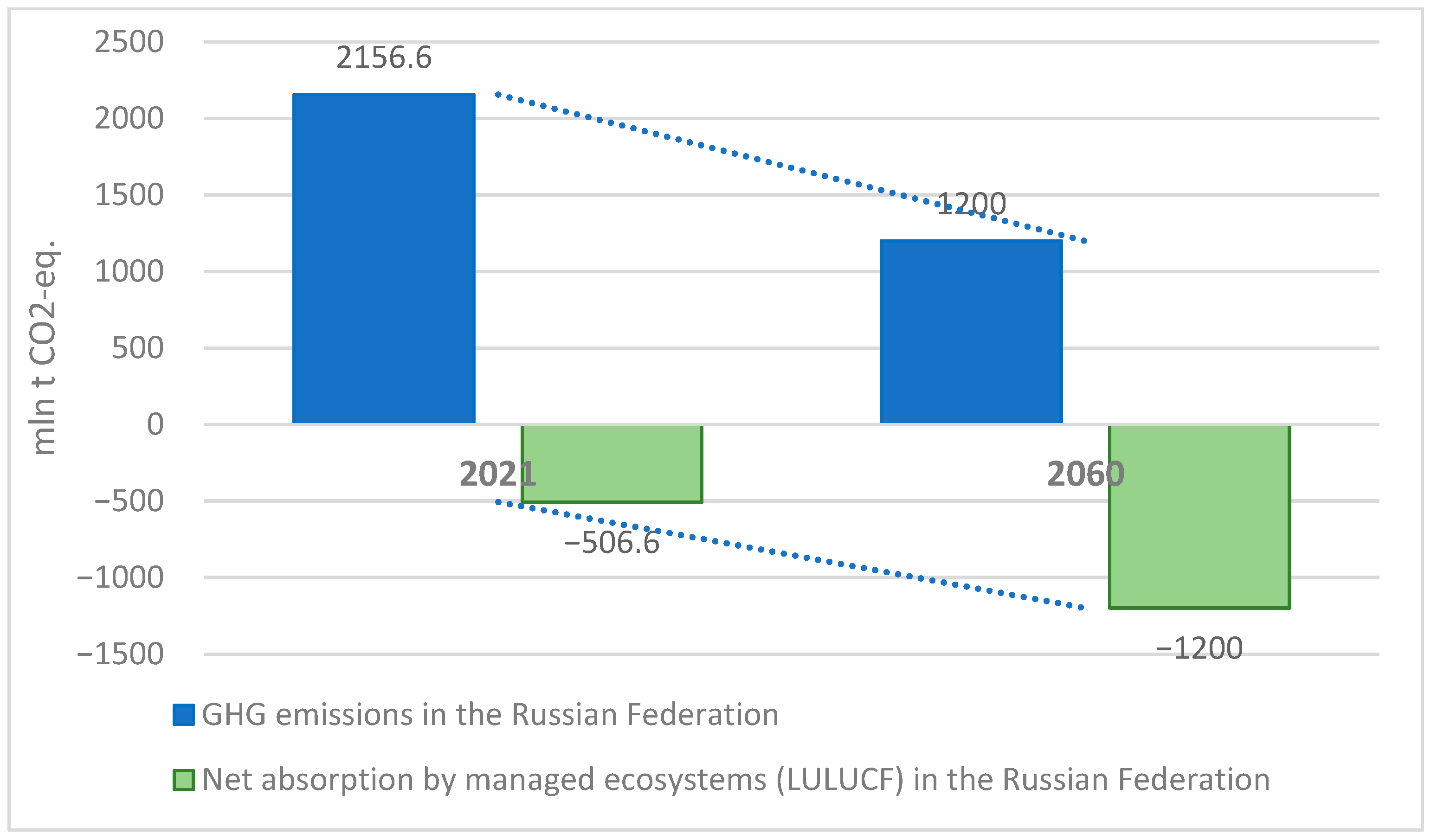
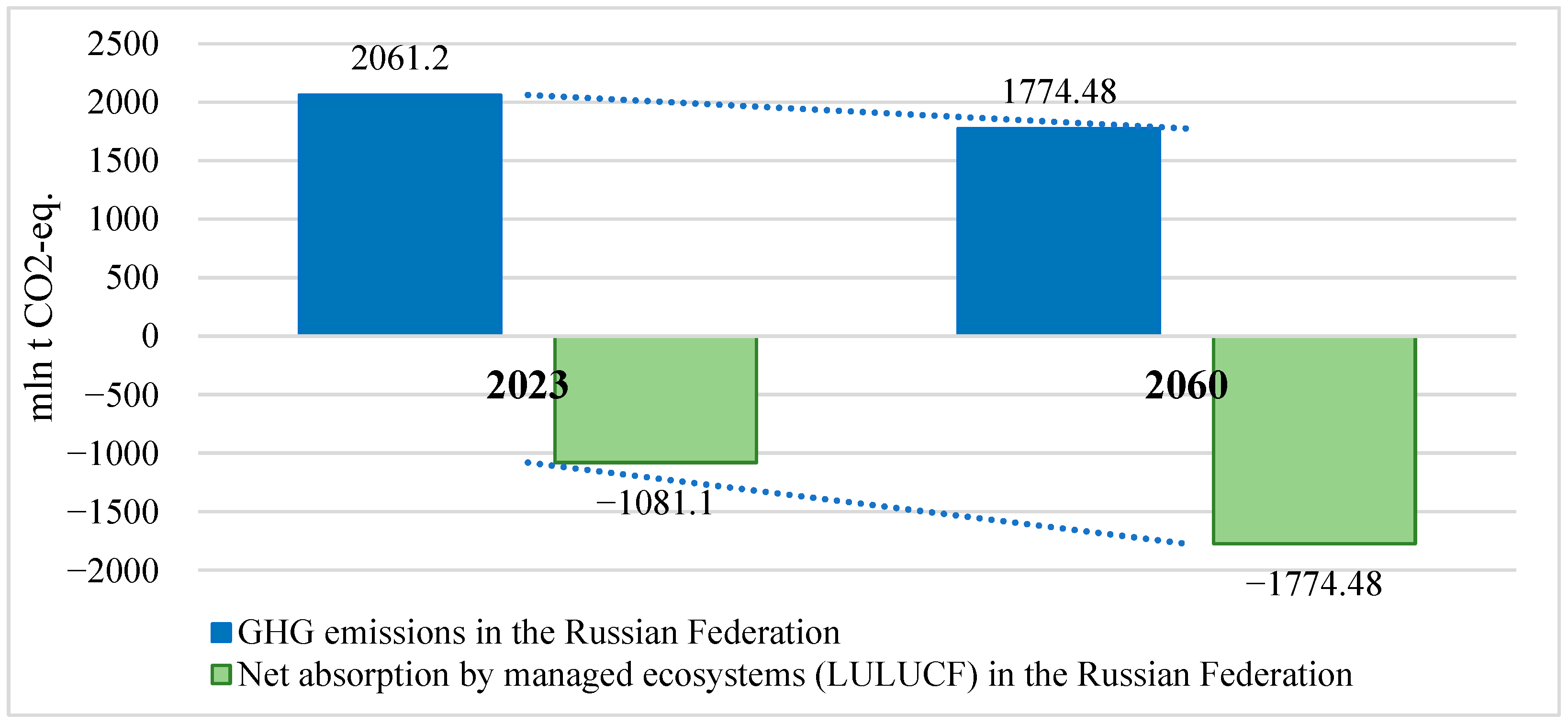
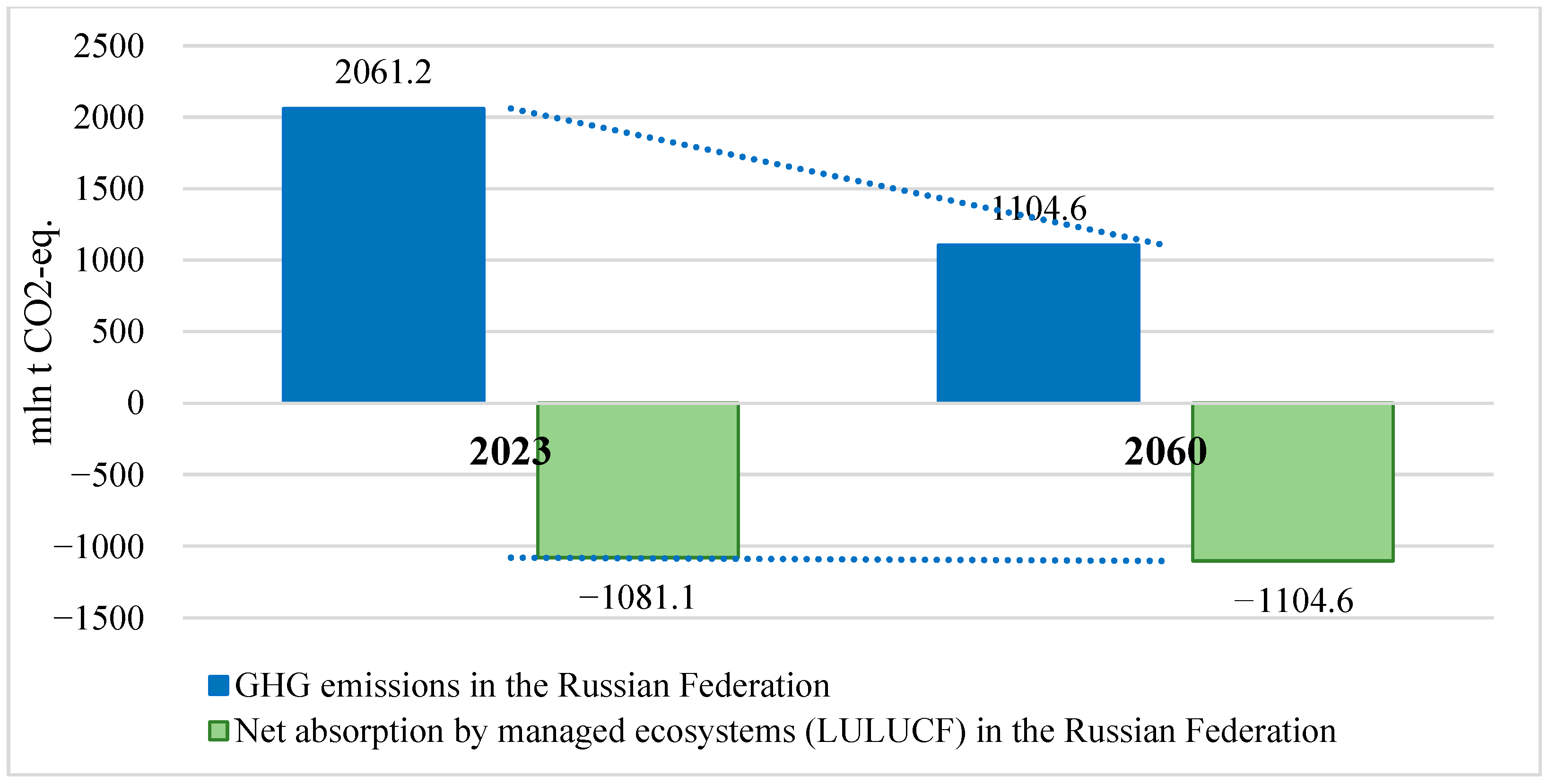
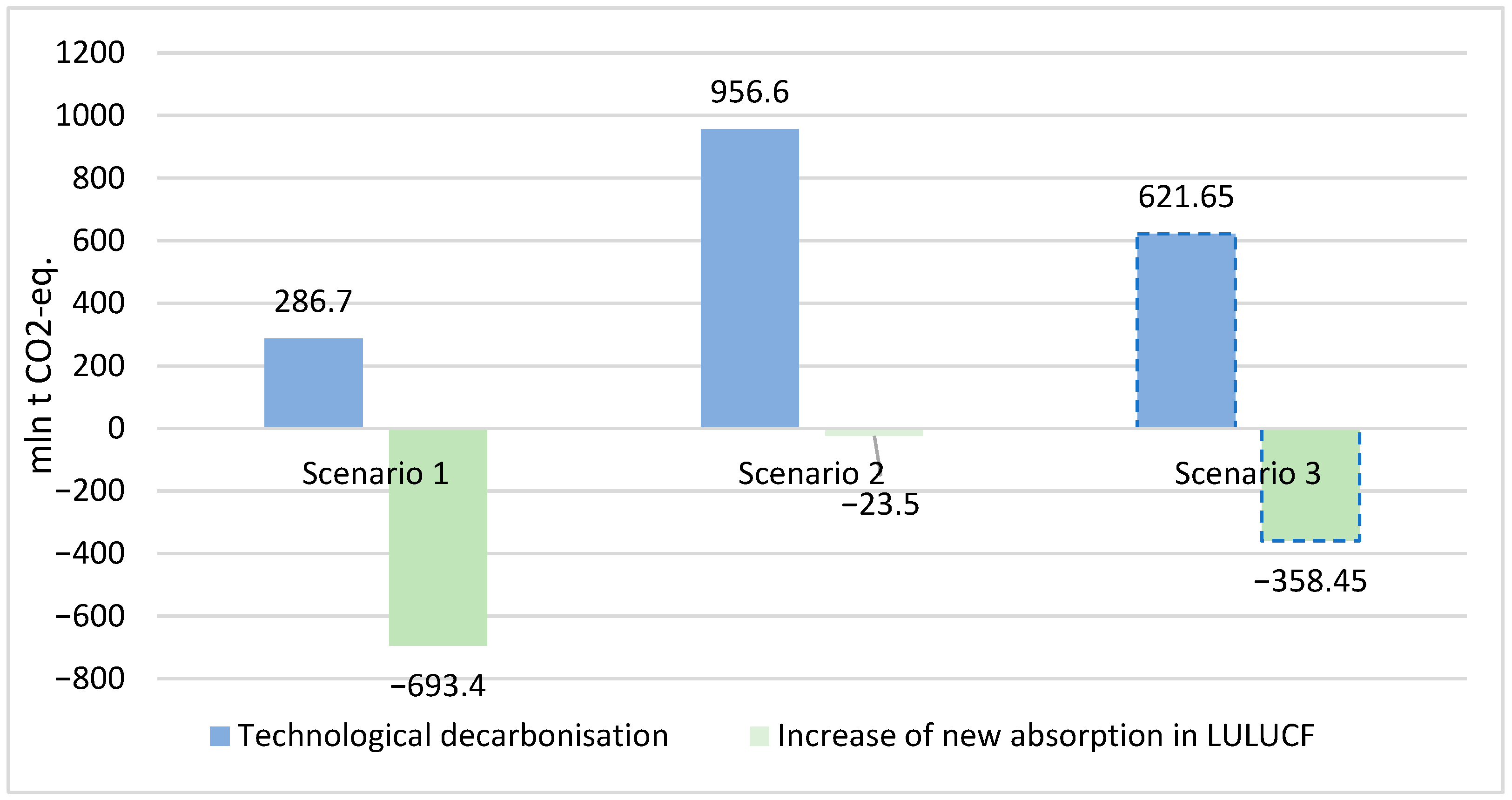
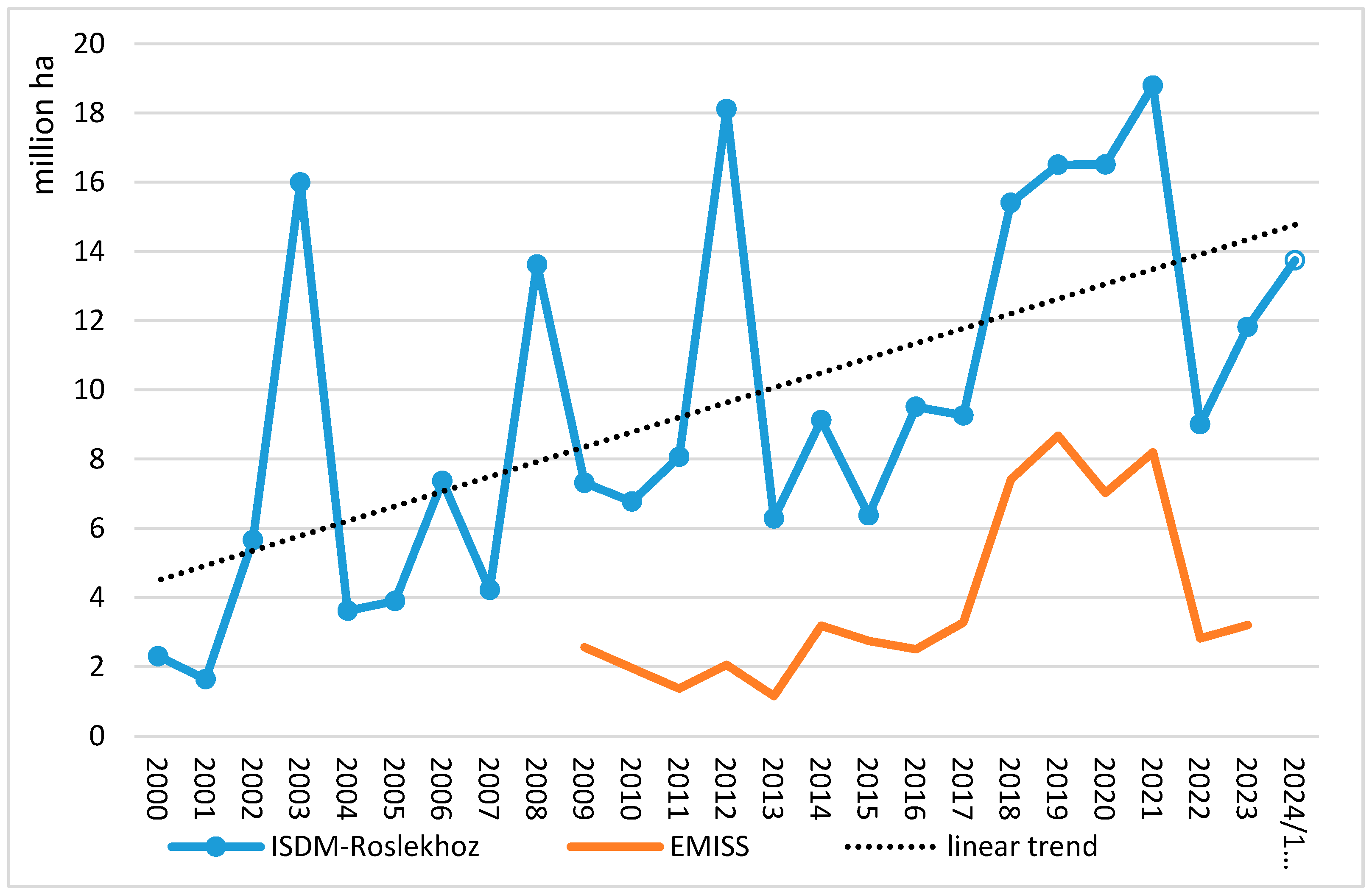
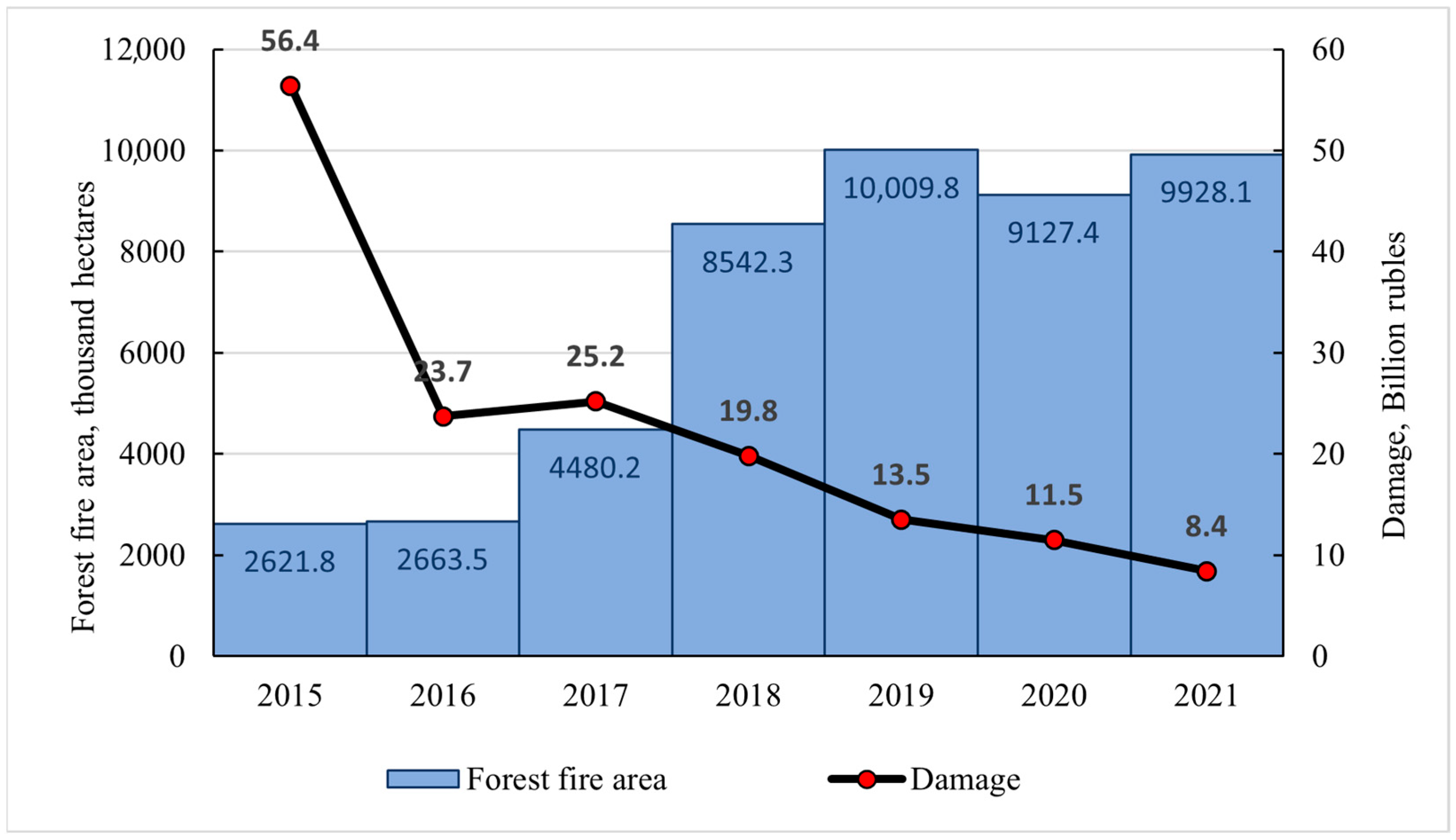
| GHG Emissions Without LULUCF, Mln t CO2-eq. | GHG Net Absorption by LULUCF, Mln t CO2-eq. | GHG Net Absorption by Managed Forests | ||||
|---|---|---|---|---|---|---|
| Year | NID 24 | NID 23 | NID 24 | NID 23 | NID 24 | NID 23 |
| 2018 | 2087.3 | 2145.2 | −1083.2 | −577.3 | −943.7 | −624.3 |
| 2019 | 2077.3 | 2136.5 | −937.8 | −550.5 | −880.4 | −618.2 |
| 2020 | 2001.3 | 2061.1 | −1194.1 | −557.6 | −1082.5 | −616.2 |
| 2021 | 2098.1 | 2156.6 | −961.5 | −506.6 | −904.5 | −614.4 |
| 2022 | 2042.0 | nd | −1228.8 | nd | −1058.4 | nd |
| Average for the period | 2061.2 | 2124.9 | −1081.08 | −548.0 | −973.9 | −618.3 |
| Research | Years of Modeling | Mt C per Year |
|---|---|---|
| [67] Laboratoire des Sciences du Climat et l’Environnement | 2000–2004 | 600–700 |
| [68] US Forest Service | 2000–2009 | 474 |
| [68] US Forest Service | 2010–2019 | 330 |
| [69] Vrije Universiteit Amsterdam | 2012 | 690 ± 246 |
| [70] | 1990–2010 | 505–611 |
| [71] Institute of Economic Forecasting of the Russian Academy of Sciences | 1990–2010 | 500–650 |
| [72] Center of Forest Ecology and Productivity of the Russian Academy of Sciences | 2013 | 200 |
| [73] Carbon Budget Model of the Canadian Forest Sector (CBM-CFS3) | 2014 | 255 |
| [74] International Institute for Applied System Analysis (IIASA), Austria | 2007–2009 | 546 ± 120 |
| [75] | 1988–2014 | 530–595 |
| [67] World Resources Institute, USA | 2000–2019 | 1400+ |
| [42] | 1988–2014 | 354 |
| [20] | 2017–2021 | 256–320 |
| [5] (only managed forest land) | 2000–2009 2010–2022 | 432 312 |
| 3.2.1 Main measures in the field of assessment of the absorption capacity of forests and other ecosystems |
|
| Measures to increase the absorption capacity of ecosystems |
|
| 3.2.2. Stimulating the implementation of climate projects |
|
| Assessment of the Target Potential for Increasing GHG Absorption in LULUCF | Changing the Methodology for Assessing Absorption | Climate Projects | Measures (Government Fundings) |
|---|---|---|---|
| LT LEDS | 665 | ||
| IGCE | 545–940, in forests 235–480 | ||
| LT LEDS Operational plan | no data available | 100 (by 2030) | 400 |
| IG RAS | 85 | 200 (by 2050) | 100–150 |
Disclaimer/Publisher’s Note: The statements, opinions and data contained in all publications are solely those of the individual author(s) and contributor(s) and not of MDPI and/or the editor(s). MDPI and/or the editor(s) disclaim responsibility for any injury to people or property resulting from any ideas, methods, instructions or products referred to in the content. |
© 2025 by the authors. Licensee MDPI, Basel, Switzerland. This article is an open access article distributed under the terms and conditions of the Creative Commons Attribution (CC BY) license (https://creativecommons.org/licenses/by/4.0/).
Share and Cite
Shvarts, E.A.; Ptichnikov, A.V.; Romanovskaya, A.A.; Korotkov, V.N.; Baybar, A.S. The Low-Carbon Development Strategy of Russia Until 2050 and the Role of Forests in Its Implementation. Sustainability 2025, 17, 6917. https://doi.org/10.3390/su17156917
Shvarts EA, Ptichnikov AV, Romanovskaya AA, Korotkov VN, Baybar AS. The Low-Carbon Development Strategy of Russia Until 2050 and the Role of Forests in Its Implementation. Sustainability. 2025; 17(15):6917. https://doi.org/10.3390/su17156917
Chicago/Turabian StyleShvarts, Evgeny A., Andrey V. Ptichnikov, Anna A. Romanovskaya, Vladimir N. Korotkov, and Anastasia S. Baybar. 2025. "The Low-Carbon Development Strategy of Russia Until 2050 and the Role of Forests in Its Implementation" Sustainability 17, no. 15: 6917. https://doi.org/10.3390/su17156917
APA StyleShvarts, E. A., Ptichnikov, A. V., Romanovskaya, A. A., Korotkov, V. N., & Baybar, A. S. (2025). The Low-Carbon Development Strategy of Russia Until 2050 and the Role of Forests in Its Implementation. Sustainability, 17(15), 6917. https://doi.org/10.3390/su17156917







